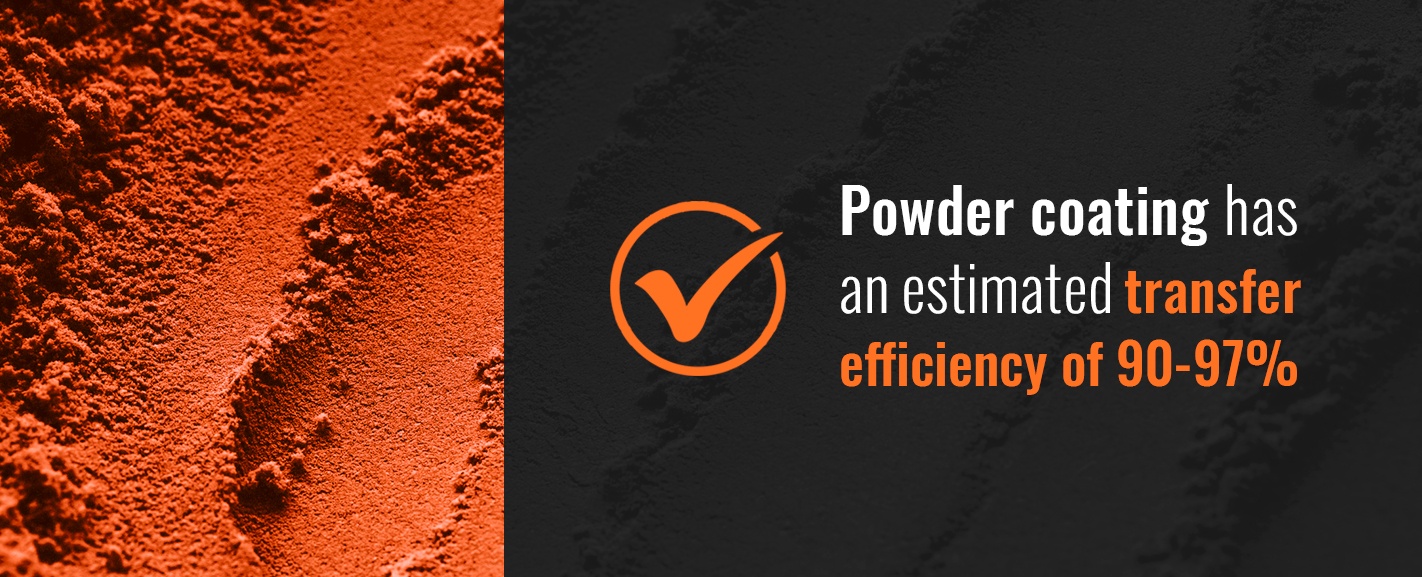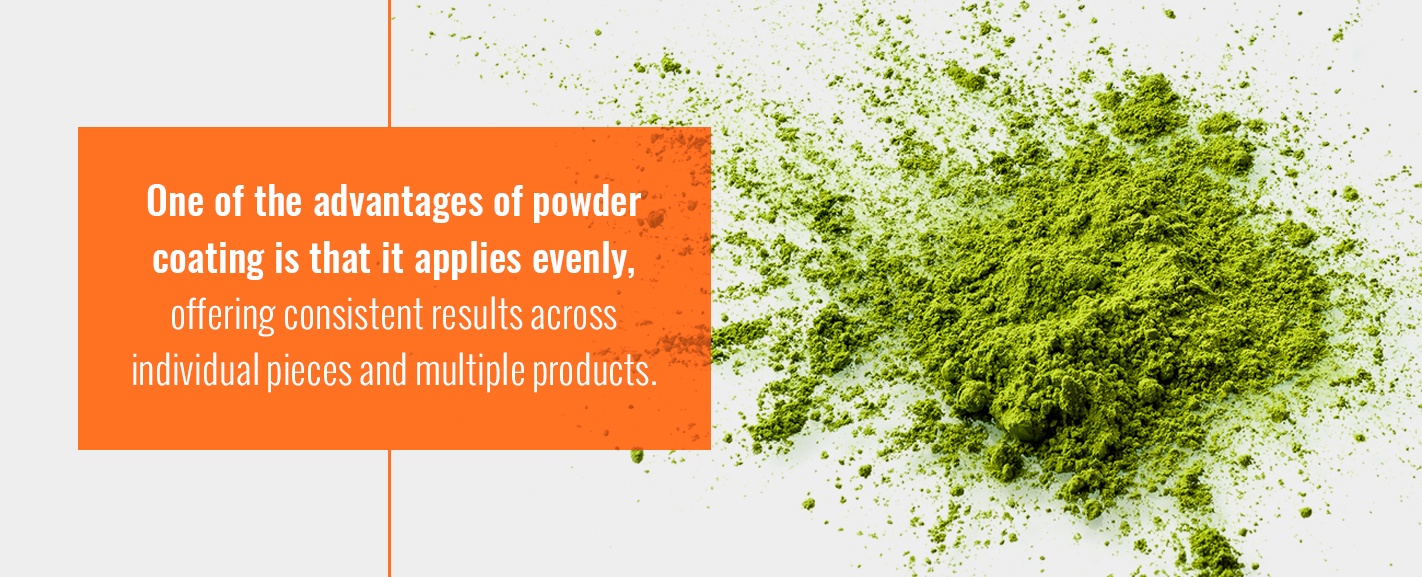
Two of the most common options for putting a finishing coat on metal products are powder coating and liquid painting. Each option has its own set of advantages and disadvantages, which means different things depending on the part you’re producing. Many industries rely on metal finishes, including aerospace, auto, appliances and more.
Powder coating involves applying a fine powder to the surface of a metal using any of various ingredients and methods that use heat or chemicals to cure the finish. An electrostatic process causes the powder to adhere to the surface. Keep reading to learn about the advantages of powder coating vs. paint and which one is better for your application.
Table of Contents
When it comes to durability, powder coating the metal is the clear winner. This characteristic is one of the primary benefits of powder coatings. Many ingredients can go into a powder coat, including acrylics, epoxy, nylon and polyurethane, some of which offer better durability than others. Regardless of the ingredients, powder coating uses electrostatic energy to bond the powders to the surface.
Because of the way it adheres to the metal, powder coating is more resistant to scratching, peeling and chipping than paint. It tends to move with the metal instead of flaking off. Once this occurs, with either finish, rust can develop more quickly. A more durable powder coat can keep rust at bay by preventing corrosive agents from reaching the metal. Plus, powder coats cannot be applied thinly, so the thicker layers help to keep the metal protected. The increased durability of powder coats makes them excellent for high-traffic or heavy-use items, like handles, fences and appliance parts.
Spray paint can peel or chip, and the number of layers applied can affect durability. When creating parts for sensitive applications, avoiding paint chips can be crucial. Applications involving food production or medical use, for instance, can’t have paint chips falling off. Although you can’t touch up a powder coat like you can a coat of paint, it is more difficult to damage the surface of a powder-finished product. Whether your focus is on creating aesthetically pleasing or functional parts, the durability of a powder coat can help make products that stand the test of time and provide customers with their money’s worth.

Speaking of getting your money’s worth, powder coating also offers a more efficient process. Paints tend to have a low transfer efficiency, resulting in excess pollution through solids, liquids and air emissions. These emissions can add to the costs of waste removal and require more paint in the first place. Powder coating, on the other hand, has an estimated transfer efficiency of 90-97%. The superior efficiency of powder can save you money on:
Another way that powder coating saves money is that any overspray can be reused before the curing process. One substantial cost of powder coating is the capital expenditure for the specialized equipment. Spray painting, however, also requires special materials and additional precautions for fumes and solvents.
Spray painting’s low efficiency can cost you in the long run. For each gallon of paint purchased, a significant percentage of it gets thrown away — and it usually costs even more to have it thrown away safely! Much of the cost benefits to powder coating are indirect, including lower waste costs, decreased labor due to a faster process and various benefits in safety mitigation, such as less ventilation-related personal protective equipment (PPE).
Powder coating also wins out on its application process. Spray paints are filled with solvents and volatile organic chemicals (VOCs), which are damaging to the environment and your health. VOCs can cause many negative symptoms to those who are exposed, so extensive PPE and training are necessary to keep employees and your facility safe. Powder coating still requires PPE but lacks the solvents that create dangerous fumes and VOCs in paint, so ventilation is much less complicated. It also tends to be easier to keep the powder off of skin due to less overspray. Particles are relatively contained.
One downside to powder coating is that it requires specialized equipment, making it less feasible for hobbyists or small part runs unless you are outsourcing the work. Several cleaning requirements need to be met before applying the powder coats, as you need to remove any foreign items on the metal’s surface, such as:
Sometimes specialized cleaning rooms can help accomplish this. Compressed air, wash stations and drying ovens can make this process effective and faster for large-scale operations.
Powder coats take time to cure, but it is typically much faster than spray paint, which can take several days to dry completely. Liquid painting can also take several coats, with dry time in between each one, while powder finishing takes only one layer, reducing labor and materials needed. This, of course, speeds up the production process, making room for more products to move through your facility and increase your output.
One crucial difference between the two methods is the use of heat, which means you cannot powder coat materials that you can’t expose to high temperatures. Materials like glass and some plastics can be powder coated, but a meltable substance like rubber cannot. This characteristic can limit the applications, whereas spray paint works on almost any surface.
The color and texture of a powder finish is an appealing look that many appreciate. It wouldn’t be uncommon to see powder-coated appliances and pieces of furniture within a house. They have a tough, slightly textured surface, though thicker layers can add smoothness. A matte finish is typical with powder coatings, but high-gloss finishes are achievable. Powder coats can maintain their color for longer than paint, especially when exposed to UV rays. We offer powder coating that offers exceptional UV resistance.

Anyone who has ever painted a surface knows how its behavior can make getting an even coat difficult. Paint tends to pool in areas and can vary widely in thickness. One of the advantages of powder coating is that it applies evenly, offering consistent results across individual pieces and multiple products. Remember that powder cannot be applied in thin layers, so particularly small parts may not be suitable for this finish.
One area where powder coats can impede on consistency is in color matching. Anyone can mix liquid paint to create custom colors, and it can be done on-site. Powders are colored in their production run, and combining them creates a speckled pattern. Alternative colors typically need to be custom ordered. Ordering large batches of colors can help manufacturers maintain consistency across their products.
In many instances, powder coating is the superior finishing option for its durability, texture and ease of application. It can stay on for years and protect your parts from corrosion and rust. Powder coats look good in any home and offer a much safer application process than spray paint. While the process does require specialized knowledge and equipment, outsourcing your powder coating to the experienced team at PBZ manufacturing can counteract these costs.
We offer a one-stop-shop for manufacturing parts and applying exceptional finishes with full-service capabilities for nearly everything in between. Reach out today to learn more about our powder coating options.